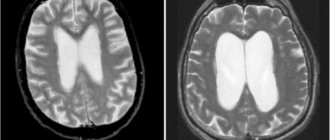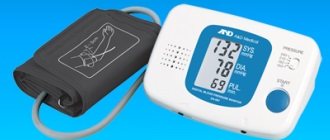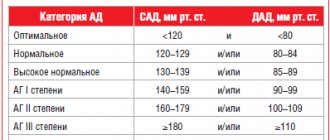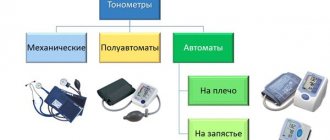- What is high or low intracranial pressure?
- How to check intracranial pressure
- What is the danger of intracranial hypertension or hypotension?
- Where can I get an MRI of the brain?
Headache, spots before the eyes, vomiting, blurry silhouettes around and the ground disappearing somewhere from under your feet - all these alarming symptoms may indicate increased intracranial pressure. But if blood pressure can be measured independently with a tonometer in just a couple of minutes and reduced with the help of one vasodilator pill, then with intracranial hypertension everything is much more complicated. Only with the advent of MRI of the brain did it become possible to carry out non-invasive diagnostics and find the cause.
What is intracranial pressure?
Nature acted wisely, placing the brain in a durable bone shell, thereby protecting it from external mechanical influence. No less wise was the decision to surround the brain with a special liquid - cerebrospinal
, which protects it from impacts on the internal surfaces of the skull bones. But for this “shock absorber” to work properly, there must be just enough fluid so that the brain is constantly exposed to a certain, same pressure, which is called intracranial pressure (ICP).
To measure or not to measure pressure?
It’s unlikely that anyone would ever think of running to the doctor when they have a headache, saying that it will hurt and stop. Hypertensive patients will immediately measure their blood pressure (fortunately, everyone has blood pressure monitors at home) and take the medication prescribed to them. Those who do not suffer from hypertension will regard their health as a reaction to weather changes or magnetic storms and will take painkillers. And no one thinks that pain in the head can be a consequence of increased ICP, which often leads to unpleasant consequences.
Just as blood flows endlessly through the vessels of our body, so too the cerebrospinal fluid—the fluid surrounding the brain and spinal cord—is not a frozen substance, but is renewed, forming in the designated parts of the brain and flowing into others. Then some part of it is absorbed into the venous blood, with which it leaves the brain. The other part moves into the spinal canal. Every day, up to a liter of cerebrospinal fluid is formed in the body: after all, it is needed not only as a “shock absorber”, like an airbag in a car, but also participates in the metabolic processes of the brain, and even has antimicrobial properties.
What is hydrocephalus of the brain, external hydrocephalus
If intracranial pressure is increased significantly and for a long enough time, the fluid cavities of the brain may expand; this expansion is called internal or external hydrocephalus. Since the cranial cavity is a closed space, the expansion of the fluid cavities of the brain occurs due to a decrease in the mass of the brain matter itself. To protect you from the death of working brain tissue, we will offer you a course of medications, in combination with a set of exercises to reduce intracranial pressure and, if necessary, osteopathic correction.
External hydrocephalus (brain) - expansion of the external cerebrospinal fluid spaces of the brain (subarachnoid spaces).
Internal hydrocephalus (brain) - expansion of the internal liquor cavities of the brain (ventricles).
Our clinic pays great attention to finding the root causes of such a condition as increased intracranial pressure. In this case, treatment can be kept to a minimum, and our assistance to patients will be reliable.
Causes of increased intracranial pressure
But as a result of some reason, more cerebrospinal fluid is formed than it should be. In this case, its pressure on the brain tissue will be excessive, that is, there will be an increase in intracranial pressure. And if the outflow is disrupted, it can increase even if the amount of cerebrospinal fluid produced is normal. There are many reasons for this.
Caused complications
The most serious complication of increased intracranial pressure is herniation of the cerebellum into the tentorial foramen with subsequent compression of the brain stem, which leads to respiratory arrest and death. Among the “milder” ones, we can mention decreased vision, up to blindness, the appearance of epileptic seizures and mental disorders.
How to measure intracranial pressure
Where to begin? Of course, with the consultation of a neurologist, by the way, the leading neurologist in Istra and the entire Moscow region, Markin I.I., works in our medical center. It is from him that you will first hear about a possible increase in your ICP. In order to confirm this assumption, you will be referred to an ophthalmologist and an otolaryngologist. The first will examine the fundus and the condition of the retinal vessels, if they are dilated, he will confirm the neurologist’s assumption. The second will do the same if, upon examination, he discovers a deformation of the eardrum. After this, a more precise examination and, if necessary, measurement of this pressure can be prescribed.
You should know that you can easily measure blood pressure at home, but ICP can only be measured in a hospital and only by a specialist.
Symptoms and treatment
Symptoms of intracranial pressure
Change in pupil reaction;- Swelling of the optic nerve;
- Problems with vision (peripheral vision is impaired first, and then central vision). Acuity decreases, diplopia occurs;
- Reduced hearing threshold;
- Dyspeptic syndrome consisting of nausea and vomiting;
- Severe headache that lasts for a long period of time, a feeling of constant fatigue and drowsiness;
- Pain when turning the head, as well as when sneezing and coughing;
- Sudden hyperhidrosis (production of a large amount of sweat), a sharp decrease in blood pressure;
- Irritability, nervousness, decreased ability to work;
- The occurrence of hematomas in the periorbital area;
- Pain in the cervical vertebra and spinal cord;
How to treat increased intracranial pressure?
It is necessary to understand that the condition in question is not an independent nosological unit, but a symptom of some disease that affects the human nervous system. Only after the pathology, the presence of which leads to an increase in intracranial pressure, has been identified, will it be possible to draw any conclusions. After all, it is reliably known that treatment of intracranial pressure (increased), equally as treatment of any other somatic pathology, can only be effective if its root cause is determined for the purpose of further elimination, and nothing else.
It is in order to correctly identify the root cause of the pathology that it is necessary not only to conduct a number of laboratory and instrumental studies, but also to consult a competent specialist who can interpret the results obtained, compare them with indicators of the objective condition, and then draw appropriate conclusions and select the correct treatment that will will relieve the symptoms discussed above.
If you notice signs of increased intracranial pressure, do not delay your visit to the doctor, this will need to be done as soon as possible, since what matters here is when exactly the necessary treatment will be prescribed.
The most experienced and competent neurologist in Tushino conducts an appointment in our clinic. Hurry up to sign up, because if treatment is started on time, it will be much easier to get rid of the pathological condition before the disease manifests itself and does not lead to undesirable consequences.
Get advice on visiting a neurologist. Consultation on the service does not oblige you to anything.
How to treat intracranial pressure?
There is also no need to say that if there is a serious pathology of the brain, treatment is carried out in a hospital, in the neurology department. Where surgical intervention is required - in neurosurgery.
What can you do yourself when you already know that, for example, after a concussion, your ICP periodically increases. The most effective thing is to take a diuretic, and best of all, diacarb, which not only removes excess fluid from the body, but also reduces the production of cerebrospinal fluid in the brain.
No-spa relieves brain spasms well. But this is only as an emergency aid; further treatment is prescribed and controlled by a doctor.
ICP norms of intracranial pressure in children and adults (from open sources)
Intracranial pressure in newborns is normally lower than in older children and adults. It should be taken into account that the normal numbers can change both up and down, but this will not mean that the child is sick. Increased or slightly decreased intracranial pressure in newborns and children may be due to exposure to some external irritants. For example, a cold or, conversely, hot room, emotional state (when, say, the baby was upset about something, the mother scolded or did not buy the desired toy, when the child did not get enough sleep) and even the posture when measuring ICP. Normally, intracranial pressure in infants, children and adults is measured in the supine position.
- Intracranial pressure in children is normally 3–7 mmHg. Art.
- Intracranial pressure in newborns is 1.5–6 mmHg. Art.
- Intracranial pressure in adults is 3–15 mmHg. Art.
Methods for reducing pressure
If ICP increases due to an existing secondary process, the primary disease must initially be eradicated, for example, hormonal imbalance, atherosclerosis, osteochondrosis or hypertension. But symptomatic treatment of this disease is also very important.
The patient can independently determine the symptoms, and treatment for intracranial pressure is prescribed by a specialist. It will be as follows:
- Conservative: taking medications to enhance the outflow of excess blood from the brain, reducing the pressure of the cerebrospinal fluid as much as possible. Doctors mostly prescribe diuretics. If a tumor or meningitis is detected, steroid-type anti-inflammatory drugs are prescribed to reduce swelling. Doctors also recommend using potassium supplements and agents to improve venous blood flow. Nootropic drugs will be ineffective for this disease.
- Surgical. The most commonly used type of surgery is bypass surgery. A special tube is inserted through which excess fluid is pumped from the ventricles of the brain into the peritoneum. But there are also some disadvantages - the catheter can unexpectedly break, bend or become clogged. There are also a number of specific complications of this procedure.
To reduce intracranial pressure, tinctures of mint, hawthorn, medicinal valerian, eucalyptus or motherwort are used. These herbs eliminate vascular spasms, providing a mild calming effect on the patient.
Diagnostics (or how can you measure it)?
Spinal puncture gives us absolutely accurate numbers , but it can only be done in a hospital setting. This is a rather unsafe and traumatic procedure. And they do it only according to indications, when there is a threat to the patient’s life. In this regard, to clarify intracranial pressure, we recommend doing at least two studies.
This is Doppler ultrasound . The most informative study in this situation is that we see the blood supply - how the brain is nourished - this is arterial blood flow, and we also see the venous outflow - how waste food from brain cells is disposed of. And this is already a serious step in finding the cause of intracranial pressure.
Echoencephalography - we look to see if our brain is symmetrical, if the third ventricle is dilated (a sign of intracranial pressure - ICP).
Examination of the fundus by an ophthalmologist , where there may be congestion.
Well, let’s say things like: computed tomography , nuclear magnetic resonance , that is, layer-by-layer scanning of the brain. But even there it is impossible to directly touch and see the intracranial in numbers. There we already see its consequences. I will say figuratively, just as a tractor or bulldozer passes and we see its mark on the ground, so in these studies, on the very substance of the brain, a rough imprint of intracranial pressure is noticeable, which, alas, it leaves there.
Express laboratory . This is a blood draw without blood, that is, the skin is not broken during the study. The information is read by microsensors using the infrared spectrum. On average, this study takes 30-40 minutes. We see 131 blood indicators. And, in particular, the width of the 3rd ventricle and the pressure of the cerebrospinal fluid, and by these signs one can also judge whether there is intracranial pressure or not.
A little anatomy
This disease is associated with the cerebrospinal fluid that washes the brain and the brain itself. Liquor is an important intracranial fluid, the entire volume of which regulates pressure on the human brain.
If the volume of fluid is much higher than normal, this may cause an increase in pressure. That is, it can be noted that an increase in intracranial pressure is a set of symptoms, but not a disease as such. Read more about the symptoms and treatment of intracranial pressure below.
Decreased
Symptoms occur when the intracranial pressure drops to less than 10 mmHg (normal intracranial pressure). A person is bothered by a strong, squeezing and rather sharp headache. When the pressure decreases, “floaters” and flashes may appear before the eyes, discomfort is felt in the stomach, and a tingling sensation begins in the heart. Signs of decreased intracranial pressure also include motion sickness, loss of strength, and increased irritability. When bending down, the pain in the head may ease.
A severe and regularly recurring headache that surrounds the entire head may indicate increased ICP. Particularly painful sensations intensify at night and in the morning.
If the body is in a horizontal position, cerebrospinal fluid flows out of the skull. It continues to be actively secreted, but is absorbed more slowly, so ICP, as well as the accompanying symptoms, may intensify in the morning.
If the above symptoms of high pressure inside the skull are accompanied by a temperature of more than 38 degrees, uncoordinated movements and hallucinations, the patient may have meningitis. If the symptoms include decreased memory, increased sweating, and high fatigue, it is possible that increased blood pressure has developed due to a tumor in the brain.
Symptoms resulting from a fall or head injury may be associated with impaired consciousness and may also indicate possible brain damage. A person in this situation should immediately consult a doctor and undergo a thorough examination.










